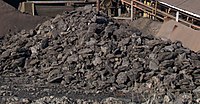
Photo from wikipedia
Abstract Humic acid (HA) is a readily available and low-cost material that is used to enhance crop production and reduce nitrogen (N) loss. However, there is little consensus on the… Click to show full abstract
Abstract Humic acid (HA) is a readily available and low-cost material that is used to enhance crop production and reduce nitrogen (N) loss. However, there is little consensus on the efficacy of different HA components. In the current study, a soil column experiment was conducted using the 15N tracer technique in Dezhou City, Shandong Province, China, to compare the effects of urea with and without the addition of weathered coal-derived HA components on maize yield and the fate of fertilizer-derived N (fertilizer N). The HA components were incorporated into urea by blending different HA components into molten urea to obtain the three different types of HA-enhanced urea (HAU). At harvest, the aboveground dry biomass of plants grown with HAU was enhanced by 11.50–21.33% when compared to that of plants grown with U. More significantly, the grain yields under the HAU treatments were 5.58–18.67% higher than the yield under the urea treatment. These higher yields were due to an increase in the number of kernels per plant rather than the weight of individual kernels. The uptake of fertilizer N under the HAU treatments was also higher than that under the urea treatment by 11.49–29.46%, while the unaccounted N loss decreased by 12.37–30.05%. More fertilizer-derived N was retained in the 0–30 cm soil layer under the HAU treatments than that under the urea treatment, while less N was retained in the 30–90 cm soil layer. The total residual amount of fertilizer N in the soil column, however, did not differ significantly between the treatments. Of the three HAU treatments investigated, the one with an HA fraction derived from extraction with pH values ranging from 6 to 7, resulted in the best improvement in all assessment targets. This is likely due to the abundance of the COO/C–N=O group in this HA component.
Journal Title: Journal of Integrative Agriculture
Year Published: 2019
Link to full text (if available)
Share on Social Media: Sign Up to like & get
recommendations!